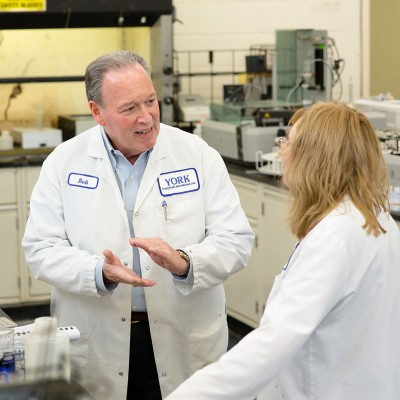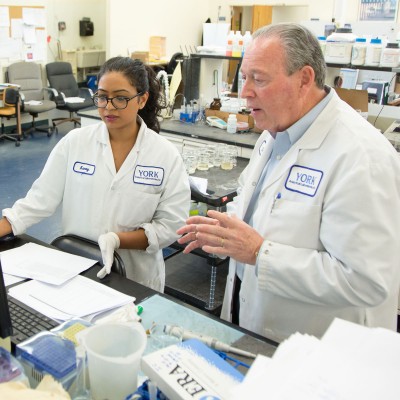 With over four decades in the environmental analysis industry, Bob Bradley, York’s Chief Technology Officer, has seen it all and had a hand in innovating new testing and methodologies that have become industry standards. In a two-part Q&A, he shares what clients should know about PFAS analytical testing, advancements, state requirements, lab capabilities, and job site handling.
With over four decades in the environmental analysis industry, Bob Bradley, York’s Chief Technology Officer, has seen it all and had a hand in innovating new testing and methodologies that have become industry standards. In a two-part Q&A, he shares what clients should know about PFAS analytical testing, advancements, state requirements, lab capabilities, and job site handling.
PFAS testing in layman’s terms: Please explain what York provides since PFAS is a relatively new environmental issue.
The basic procedure involves extraction of the PFAS into a solvent, followed by the concentration of the PFAS on media. This media is then extracted with a solvent, concentrated to a small volume, and analysis is conducted using HPLC/MS-MS (high-pressure liquid chromatography/tandem Mass Spectrometry).
The procedures used to allow us to get down to low parts per trillion (ppt) levels in water matrices and low parts per billion (ppb) (less than 2 ppb) levels in the soil.
What are the types of job sites and industries generating PFAS analytical requests? What areas will grow in PFAS testing requests?
Most of the PFAS projects for non-potable water and soil are coming from new remedial investigations as part of the programs. Also, any site where suspected PFAS use was noted (airports, fire training facilities, etc.) are requiring soil and groundwater monitoring.
In terms of growth for PFAS testing, the growth will come from potable water monitoring and, as data is gathered from this, remediation of the water systems will require routine testing.
We foresee that all new remedial investigations will include PFAS determinations to be part of the work plans. So, growth will come from both the potable water markets and consulting engineering remediation markets.
What are the challenges our clients face in sending us samples? What needs to happen?
The main challenges are educating the field samplers (our clients) on proper sampling techniques and the need to exercise caution with sampling protocols and handling since we are analyzing to extremely low levels (ppt). Proper containers, proper preservation, and proper chain-of-custody are all germane to a successful program.
What changed over the last two years in PFAS environmental studies and consulting?
Over the past two years, changes on a State level on how to investigate the PFAS issue have been evident. However, COVID-19 has put these efforts a bit behind by over a year.
New York has issued regular guidance on non-potable water and soils and continues to drill down their requirements in terms of sampling, action levels, and reporting. This has been done mainly to ensure a consistent approach to analysis since no EPA promulgated methods exist that meet their needs. No Laboratory certification is offered for other than potable water, and the New York State Dept. of Environmental Conservation (NYSDEC) has required labs to be certified for potable water as a de facto certification for the other matrices.
New Jersey does not offer certification for PFAS in soils currently but does offer certification for non-potable waters and potable waters using approved EPA methods.
 In the near future (1-2 years) the certification process will change as EPA promulgates a validated method for both soil and non-potable waters and the current potable water certifications expand the list to cover more PFAS species.
In the near future (1-2 years) the certification process will change as EPA promulgates a validated method for both soil and non-potable waters and the current potable water certifications expand the list to cover more PFAS species.
As more sites are examined and need possible remediation, the TOP Assay (Total Oxidizable Precursors) concept will become a useful tool for the engineering community to design systems that accommodate a more complete picture of non-target PFAS oxidizable precursors.
What’s changed in PFAS analytical testing?
In terms of PFAS analytical testing, the changes have mainly been on a state-by-state basis. For New York, a major focus has been placed by specific counties and municipalities on potable water supplies to monitor specific PFAS species (mainly PFOA and PFOS down to 10 ppt).
This also applies to Connecticut and New Jersey. The current EPA methods are still in play (EPA 537.1 is the most common) and, as we emerge from COVID-19, more focus is being placed on potable water supplies in the tri-state area.
In terms of soil, groundwater, and wastewater specific, states are pushing on a project-by-project basis and this will become more prevalent once the EPA promulgates a reference method and states gear up to offer certification for those methods to laboratories.
Is there a difference between PFAS analytical testing requirements in Connecticut, New York, and New Jersey?
There are differences in providing PFAS analysis. For potable water, the requirements are somewhat alike in terms of allowed EPA methods and reporting limits down to approximately 2 ppt. However:
- For New Jersey, they require reporting PFOA, PFOS, and PFNA, whereas New York and Connecticut only defer to PFOA and PFOS.
- Since New York only offers certification for PFOA and PFOS this forces laboratories to apply to New Jersey as their primary accreditation authority for one PFAS compound: PFNA.
- This process is costly and if one is an out-of-state lab New Jersey will take up to a year to do an on-site assessment and grant approvals.
- For certain counties within New York, if detections of PFOA and PFOS exceed 10 ppt, the lab is to analyze a second sampling for all 18 EPA 537.1 PFAS species.
For soils and groundwaters, there are specific, notable differences and licensing requirements. For the state of New York, there is no certification for non-potable water or soil; however, the NYSDEC is requiring the lab to possess potable water certification as a defacto certification.
For Connecticut, there is no certification for soil or groundwater at this time.
For New Jersey certification for soil is not being granted currently. For non-potable water, they are certifying to the lab’s SOP. However, that would make New Jersey the primary accreditation authority and for an out-of-state lab, the process is as long as one year.
What other emerging contaminants outside of PFAS are we starting to see?
The other emerging contaminant of interest is 1,4-dioxane. The recent interest in potable water analysis for PFAS in municipal water supplies has gotten 1,4-dioxane to ride the PFAS wave and is being requested more each day.
For non-potable water and soil, 1,4-dioxane has also become part of a number of project work plans with PFAS to essentially run out its presence on a particular site.
How did York expand to the forefront of PFAS testing in the Greater NYC region?
In the spring of 2017, we recognized the need for analysis capabilities for this emerging contaminant. More technical literature was emerging regarding PFAS and its health effects. The state of New York was pushing the need for regulation as early as May 2018 and then soon after New Jersey began its approach.
York acquired its first HPLC/MS-MS system in early summer 2018. I developed the methods for preparation and analysis using isotope dilution with HPLC/MS-MS while developing and implementing methods for drinking water using EPA methods 537 and 537.1. I was then able to procure certification from the New York State Dept. of Health (NYSDOH) and State of Connecticut Dept. of Health (CTDOH) once for PFAS in drinking water.
In 2019, we expanded the Queen’s lab to open the first and only PFAS and Emerging Contaminants laboratory in New York City.
I also researched and developed a technique (TOP Assay: Total Oxidizable Precursors) to assist environmental consultants to determine more than the simple list of 24 PFAS species typically examined (there are now over 5,000 PFAS species). Many groundwater sites that have been impacted by PFAS use typically have PFAS precursors (PFAS species used in the manufacture or used in specific products) that may be helpful for remediation strategies.
This TOP Assay analysis is a complex preparation involving controlled oxidation of these total oxidizable precursors to yield known PFAAs (perfluoroalkyl acids). These approaches are still evolving since there is no properly promulgated EPA reference method for analysis for non-potable water and soil that meets the action levels established in the tri-state area.

